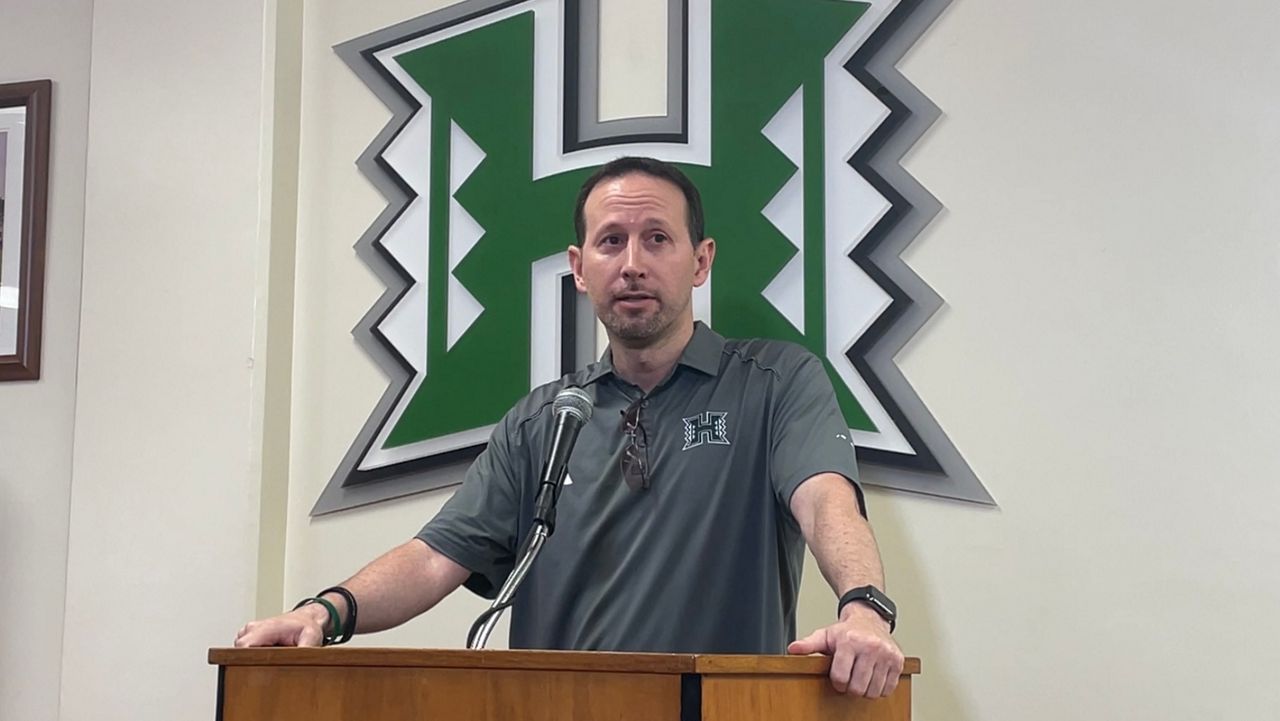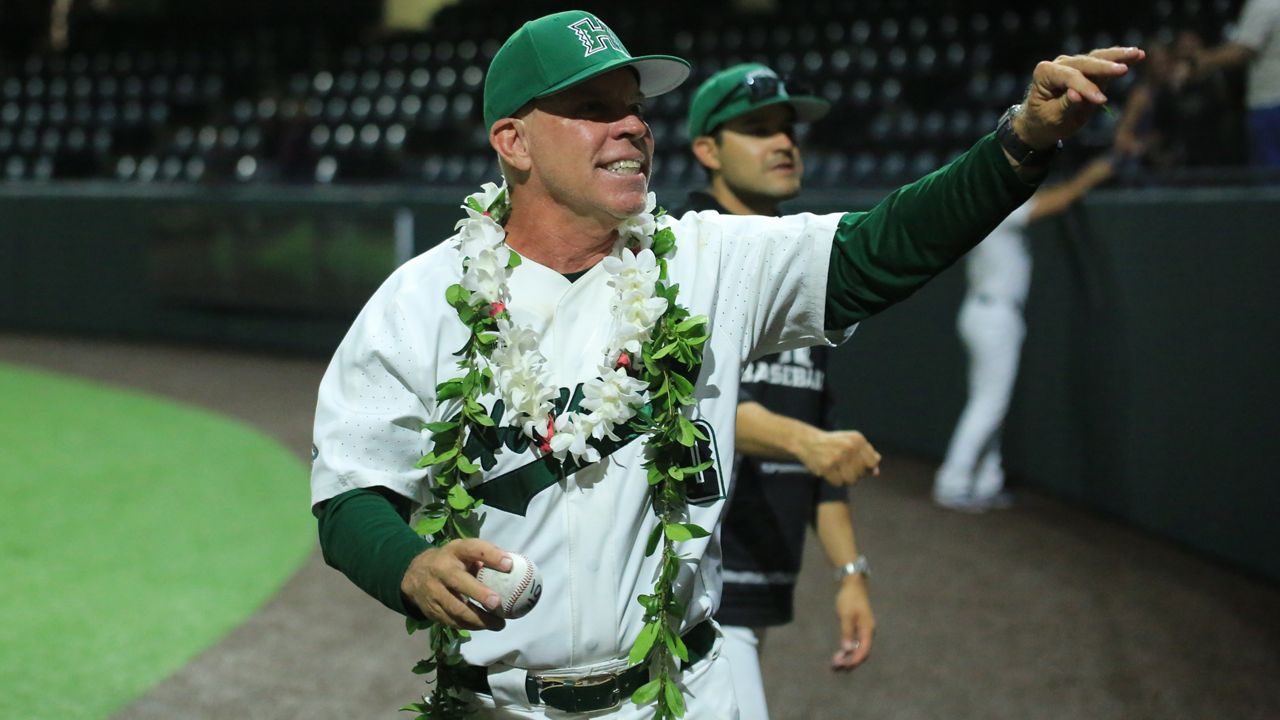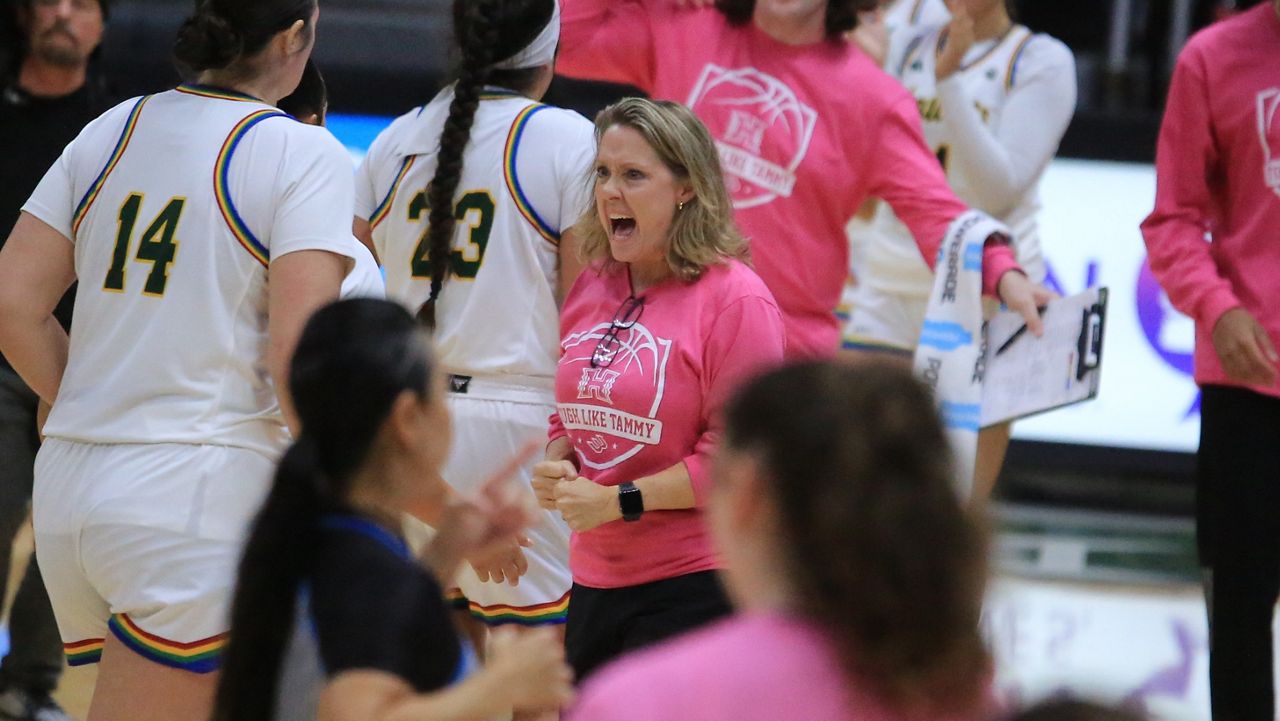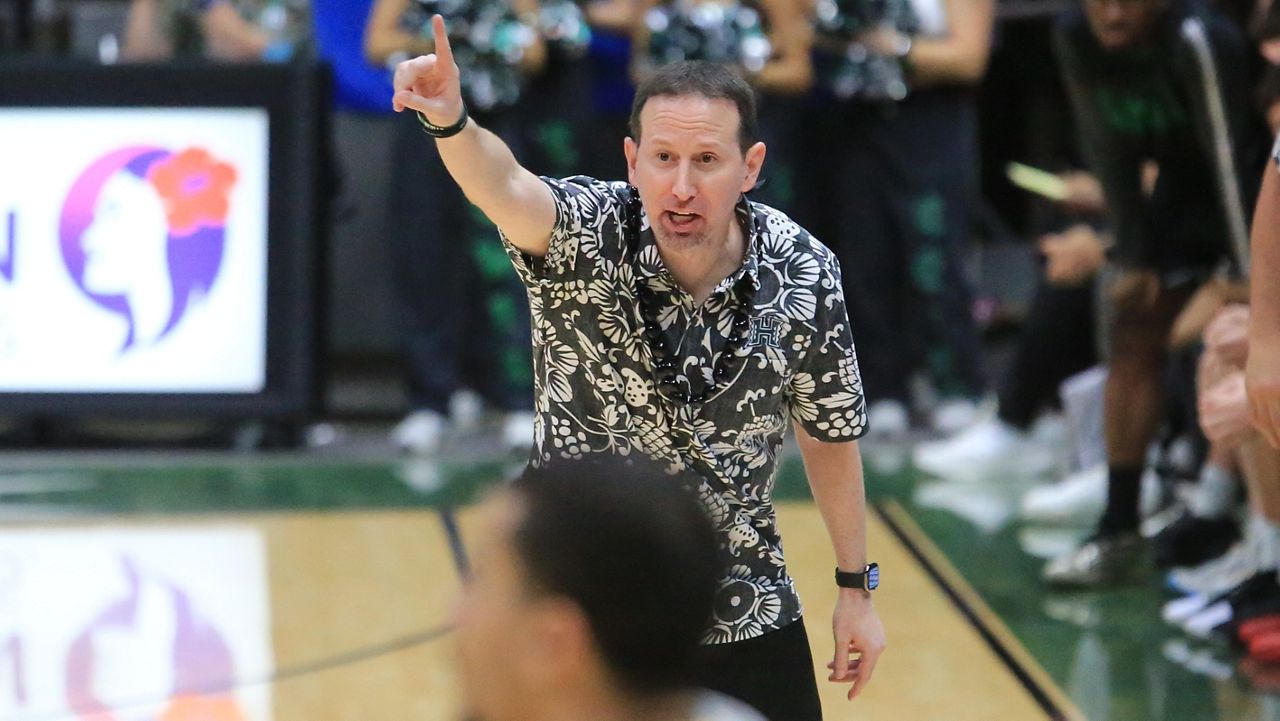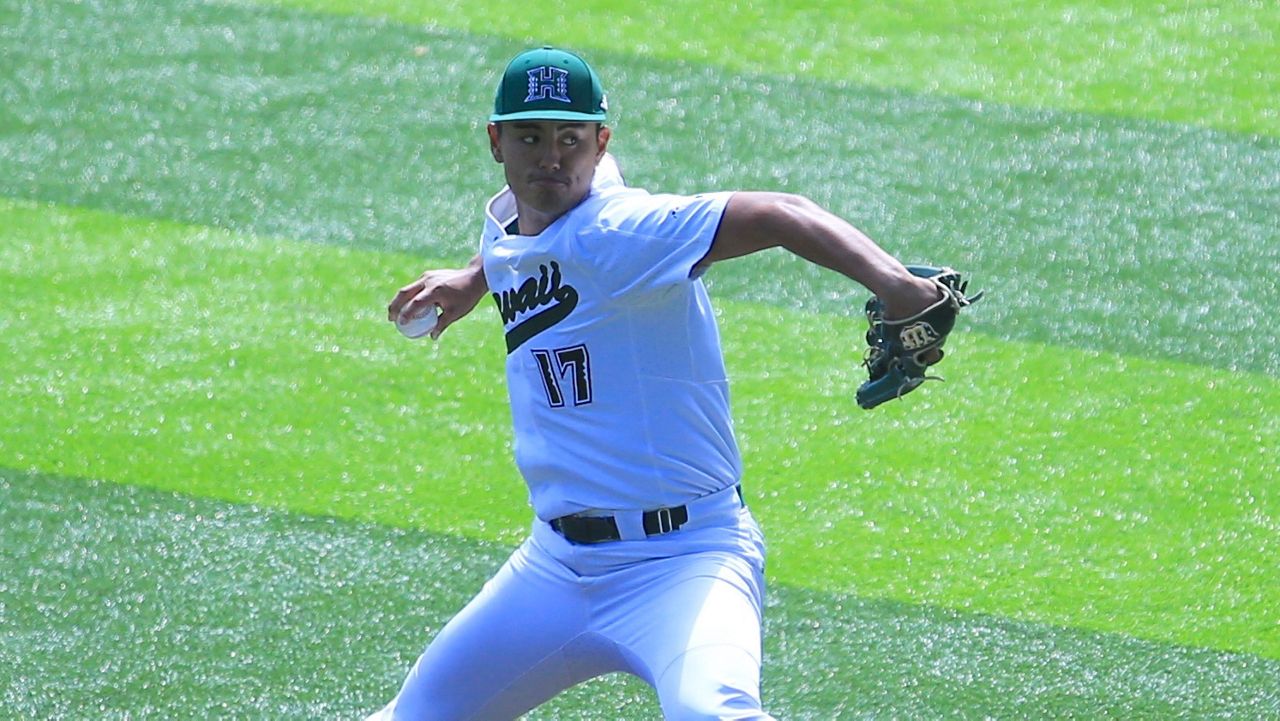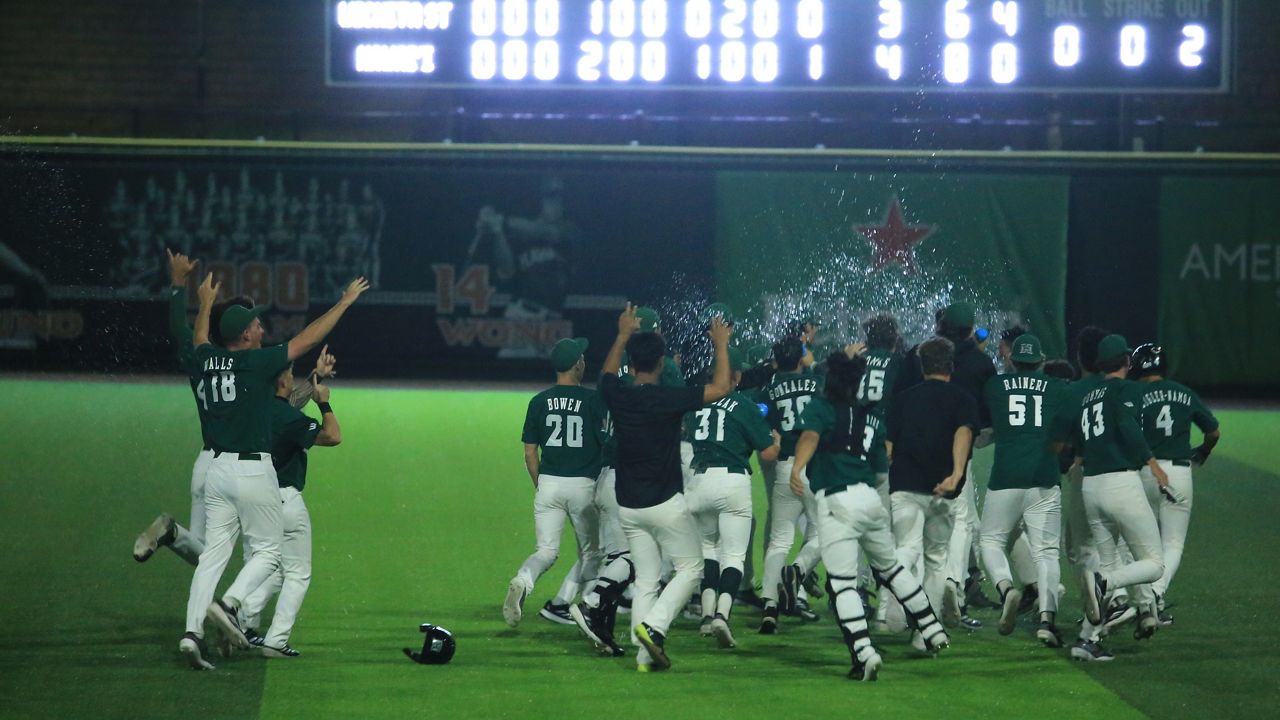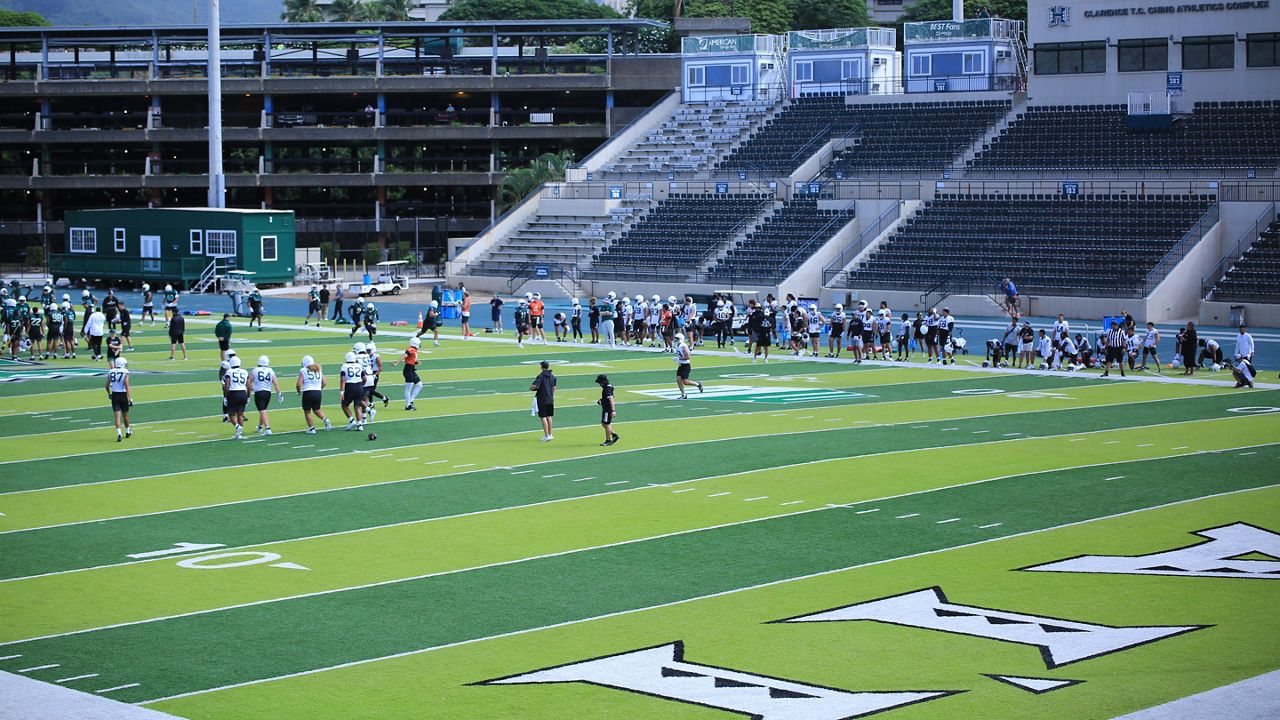HONOLULU — One by one, University of Hawaii head coaches stepped up to the podium, looked into the cameras and addressed the new world order.
They did so with a sense of anticipation, but also with a tinge of uncertainty.
UH’s move to the Mountain West Conference as a full member, announced officially on Tuesday morning, will not take effect until July 1, 2026, leaving two years of competition in the Big West for most of UH non-football sports.
Athletic Director Craig Angelos met with his head coaches recently to gauge their reaction to an impending move to align most of UH’s 20 sports with football in the MWC.
“I would have to summarize by saying most, if not all of our coaches are certainly supportive of it,” Angelos said as he fielded questions at Tuesday’s presser in the Manoa Lower Campus athletic department office. “They know it’s probably best for the overall health of our program. But certainly, some are concerned about the additional travel requirements they’ll have to do.”
The California-centric Big West, of which Hawaii has been the lone member not located in the Golden State since 2012, offered a consistent and relatively convenient travel schedule for sports like basketball, volleyball, baseball and softball. UH teams could get to their destination, usually, with a five-hour flight, plus some bus rides around Southern California or up the Central Coast.
The Mountain West of 2026 will be much more far-flung, with some cities like Laramie, Wyo., Albuquerque, N.M., and El Paso, Texas, that will require multiple flights.
“This is not about the Big West being anything but gracious and wonderful,” UH women’s basketball coach Laura Beeman said. “It’s about the opportunity in the Mountain West and our football program, obviously that’s the driving force behind everything we do. It puts them in a better position for more money, better budgets.
“Throwing all the other sports that are eligible in there, I think it’s a great opportunity.”
Here’s how coaches by sport responded to what a future in the Mountain West could look like.
Tenth-year coach Eran Ganot’s Rainbow Warriors might face the most daunting climb of any UH program. Though UH is coming off back-to-back 20-win seasons, the ‘Bows have been unable to crack into the top tier of the Big West since their NCAA Tournament breakthrough in Ganot’s first season of 2015-16. They have finished in the top three just once over that span and have struggled in March, with only two semifinal appearances and no Big West finals over the last seven tournament editions for a one-bid league.
The Mountain West, meanwhile, is widely considered one of the strongest conferences in the country in men’s basketball. Even with the departures of San Diego State, Boise State, Colorado State, Utah State and Fresno State, the Mountain West will be strong in 2026 with the likes of New Mexico, Wyoming, UNLV and Nevada. The MWC got a league-record six bids to the 2024 NCAA Tournament.
UH, which lost its nucleus from last year’s 20-14 squad, was picked to finish seventh of 11 teams in the Big West preseason poll on Tuesday.
Ganot lauded the Big West for giving UH a reliable home but acknowledged more investment must be made to prepare for the Rainbow Warriors’ new one. He alluded to the possibility of stronger scheduling in order to put UH in position to get an at-large NCAA bid.
“The NCAA has passed rules at times to separate the haves and have-nots,” Ganot said. “We’re going to make sure we’re not a have-not. That’s going to take all of us — our community, our staff, and our administration. And we’re excited about how that’s going right now.
“You’ve already seen it over the last several years, to try to upgrade our resources. We’re doing (our) homework … and studying the Mountain West and how they invest in their programs to put themselves in a position of success, whether it’s scheduling, recruiting budgets, staff sizes, all those things.”
Hawaii has been the class of women’s hoops in the Big West for the last few years; on Tuesday, it was picked to win the conference for the third straight time.
Beeman’s arrival in 2012 coincided with UH switching from the WAC to the Big West. UH has won the Big West regular season three times, made the NCAA Tournament three times and made five other postseason appearances.
She said the Mountain West will be a step up at a good time.
“I think it’s a great conference. UNLV is really on the upswing in that conference,” she said. “We’ve played a lot of teams in the Mountain West and we’ve competed with them. … Excited about the opportunity to be in that conference against really good talent.”
She was not sure that UH is ready to compete there as presently constituted as an institution, though.
“My concern is that we have to be put at a level with all of our sports budgets to be competitive,” she said. “To stay where we currently are and go into supposedly a better conference based on RPI, I think is doing us a disservice. So, I hope in the next two years there is a plan to make sure our operational budgets are where they need to be, the coaching salaries are where they need to be, recruitment and retention is huge in the age of transfer portal and NIL. And so we can’t stay where we are (financially) and go to a bigger conference. That doesn’t make sense to me.”
This is one area where UH’s competition could take a step back, which may or may not help the Rainbow Warriors get back to the NCAA Tournament for the first time since 2010.
The Big West, especially now that the old Pac-12 fell apart, is widely considered to be the elite baseball conference in the West.
Rich Hill, who is going into his fourth year at UH, acknowledged as much.
UH will bring the Mountain West up to six members in baseball, along with San Jose State, Air Force, New Mexico, Nevada and UNLV. Hill envisions a double-round-robin schedule with teams playing each other in home-and-home series.
Cal State Fullerton, UC Irvine, UC Santa Barbara and Long Beach State are among the Big West teams with a proud baseball tradition that UH will bid farewell in spring 2026.
Hill has gotten UH closer to its first Big West championship, with finishes in the top four the last few years. This spring, the Big West will debut a five-team Big West tournament.
He said recruiting would be unaffected, though he allowed that the high elevation of some MWC schools could allow for higher power numbers for his players.
“I think the focus is where we’re going, not where we’ve been,” Hill said. “Where we’re going is an exciting brand of baseball with teams that’ve produced a bunch of big-leaguers. That being said, hey, the Big West is the best baseball conference on the West Coast. No question about that. It’s the best mid-major sport in any conference in the country.
“It’s tough to say goodbye to something that appealing, and the tradition-richness of that. But we’re excited about where we’re going.”
Not every UH coach will be around to see the transition from Big West to Mountain West. Bob Coolen, UH softball’s 34th-year head coach, is set to retire after the 2025 season this spring.
He will see UH through participation in the inaugural Big West softball tournament, if the Rainbow Wahine can finish in the top six.
Six is how many softball schools the MWC is projected to have, with UH, UTEP, Nevada, UNLV, New Mexico and San Jose State.
Coolen noted that UNLV has long been a long nonconference foe of UH, which is endeavoring to reach its first NCAA Tournament since 2013.
“It’s going to be a winnable conference,” Coolen said. “I talked to Rich Hill about that. He goes, ‘we can win it every year.’ He was sure about that. He was not hesitant at all. That’s something for softball as well; if we keep our hitters home, get our pitchers from the mainland, Australia, we’ll be a competitive program in the Mountain West.”
Fourteenth-year UH soccer coach Michele Nagamine had some initial concerns about recruiting when she learned that the Rainbow Wahine could be leaving the soccer hotbed of Southern California behind.
A series of text messages from recruits allayed much of those worries, she said.
“The Mountain West for women’s soccer is an excellent conference,” Nagamine said. “They have three teams right now in the top 75 for RPI, so it will be not an easy task, but certainly the competition is great and we’re really excited about it.”
UH is in its best position to date in its Big West tenure, with a 5-0-1 conference start — a program record — heading into Sunday’s 4 p.m. home contest against UC Riverside.
Before this year, the Rainbow Wahine had struggled mightily, making only two Big West tournament appearances (2019, 2023) as the likes of Cal State Fullerton, UC Irvine and Long Beach State had their way on the scoreboard.
The Wahine will make it eight teams for the MWC in 2026, including UTEP and affiliate member Colorado College.
“I think the travel got a lot more challenging but we’re used to doing hard things here,” Nagamine said.
Coach Robyn Ah Mow did not appear at Tuesday’s press conference as the Rainbow Wahine embark on a three-match road trip this week.
However, UH, a historic powerhouse in women’s volleyball, has a track record of success against its future lineup of Mountain West opponents, many of whom it saw regularly in the old WAC.
The Wahine have made 30 consecutive NCAA Tournament appearances, though that streak will be put to the test this year as they are one of six Big West teams with a 4-2 conference record or better one-third of the way through the conference regular season.
UH’s other sports that will compete in the Mountain West besides football are men’s and women’s tennis, men’s and women’s golf, women's swimming and diving, women’s cross country and women’s outdoor track and field.
Two other aspects of UH’s move must be addressed in the near future.
First, what will happen to UH’s four Big West sports that are not sponsored by the MWC? Angelos was hopeful that men’s volleyball, beach volleyball, women’s water polo and men’s swimming and diving could remain as affiliate members in the Big West, but that will require a vote of the BWC members’ school presidents.
All four of those programs have value. Men’s volleyball won national championships in the Big West in 2021 and 2022 and is poised to welcome a stacked class of recruits under Charlie Wade. Water polo was a consistent top-10 program under retired coach Maureen Cole and beach volleyball has reliably made the NCAA championships through tenures of a few coaches. Michael Stephens was the MPSF Swim/Dive Coach of the Year as UH swept the MPSF men’s team championships in 2023-24.
Second, what will happen with its media rights deal? UH’s contract with Spectrum Sports comes up in the summer of 2025, while the Mountain West’s deal ends in 2026. UH is accustomed to having its own media rights deal separate from that of a conference, including a pay-per-view package for upward of six football games a year. But the Mountain West may seek to control UH football and men’s basketball for its new media deal, as it does for its other member schools.
“We have kind of that gap year of what we need to do, but the idea is to try to link that up with the Mountain West deal as a full member and be part of that deal going forward,” Angelos said.
“I’ve been told they’ll take football and (men’s) basketball and everything else will drop through back to the institution to figure out how you want to distribute that locally,” he added in response to a question of how a new deal might look. However, he could not say how that would work with the incumbent rights-holder, Spectrum.
Brian McInnis covers the state’s sports scene for Spectrum News Hawaii. He can be reached at brian.mcinnis@charter.com.




